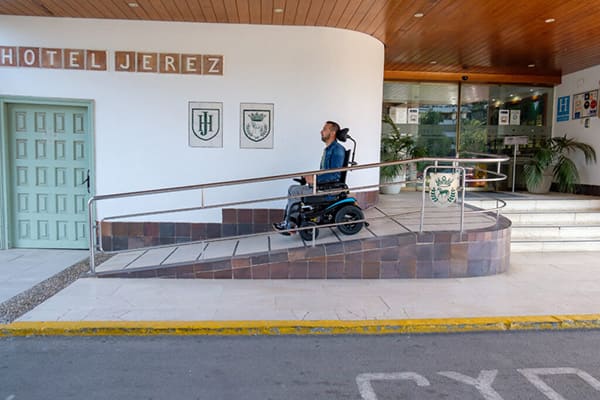A wheelchair access ramp must be adapted to meet the needs of all types of people whether it be for power wheelchairs, manual wheelchairs, mobility scooters and the elderly. It’s important to take into account the needs of these mobility users and provide them with equipment and facilities that are not only accessible but also safe for them to use. This blog will cover the characteristics of a suitable wheelchair access slope.
Measurements for a wheelchair access ramp
Length of a wheelchair access ramp
Generally, a fixed ramp cannot be longer than 9 meters. The reason for this is that if the slope is longer than nine meters, it can require excessive effort for a person who needs to manually propel their wheelchair. In most cases, it is necessary to have a ramp that is longer than 9 meters, which is why there are flat sections throughout that serve as a rest point for the wheelchair user. These breaks must be at least 1.5 meters to be a sufficient rest break.

Width for a wheelchair access ramp
The minimum width of a wheelchair access ramp must be 1.2 meters, this refers exclusively to the surface that the wheelchair can access. The reason for this is so that the ramp can accommodate all types of wheelchairs. Although 1.2 meters is the minimum requirement, however, most wheelchair ramps have a width of up to 1.5 meters.
Wheelchair access ramp slope
The slope or angle of a ramp depends on the length of the ramp.
- If the ramp is less than 3 meters, the incline should be no greater than 10%.
- If the ramp is between 3-6 meters, the maximum slope incline should be no greater than 8%.
- If the ramp is between 6-9 meters, the maximum slope incline should be no greater than 6%.
It’s extremely important to follow these regulations, as they exist for a reason! If a slope is uneven or too steep, this can cause accidents for people with disabilities and cause additional difficulties for access instead of being a solution for people with mobility limitations.

Often, only the length and width of a ramp are taken into account when designing a ramp. However, the gradual slope of all sections of a ramp is essential for anyone to safely travel. Another details often missed by ramp designers include:
- The transverse of the slope must be less or equal to 2% to prevent the wheelchair from sliding sideways.
- The floor must be non-slip to prevent falls.
- On either side of the ramp, for the entire length, the ramp must have a protective barrier of at least 12 CM high to prevent a wheelchair from derailing.
Wheelchair access ramp railing
The wheelchair access ramp must have a double handrail on either side of the slope. One between 90-105 CM and another between 70-95 CM. The distance between these rails should be 20CM. The handrails should also be extended on either end for 30CM, so people can have something to hold onto before they start their descent or ascent.
KARMA Medical are a globally recognized wheelchair manufacturer who expertly design wheelchairs and mobility scooters for people with disabilities. If you require information about your KARMA wheelchair, you can find the latest version of the user manual on the product page, or you can contact the KARMA Medical team.

 Global
Global